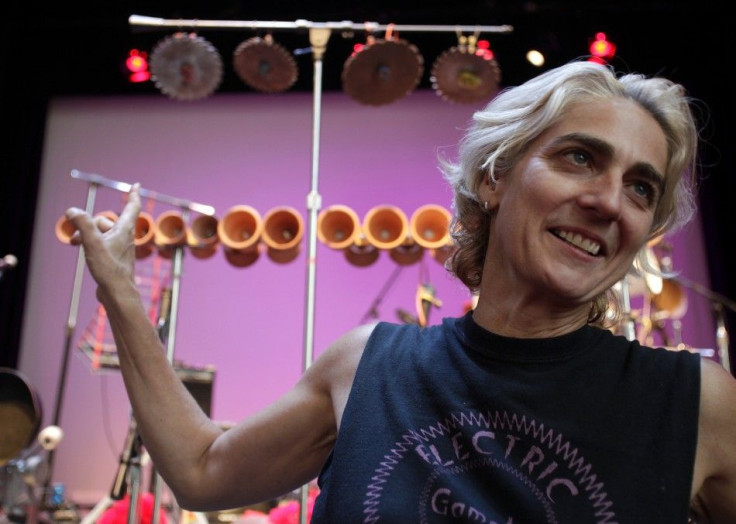Making Beautiful Music from Recycled Junk

It's all junk -- until it's not.
Clay flowerpots, a washtub, garbage cans, assorted kitchenware, an old futon frame, circular saw blades, cast iron skillets and more.
What may look like clutter piling up on a small stage at Washington's Kennedy Center for the Performing Arts is junk that has been given a second life as finely tuned, amplified musical instruments played by the New York-based group, Electric Junkyard Gamelan.
Believe it or not, the frying pans are all pitched, musician, composer, and instrument maker Terry Dame said, pointing to a black cast iron skillet standing upright on its handle near the front of the stage.
Dame is the leader of the veteran musicians who have been performing together as the Electric Junkyard Gamelan since 2000. The band members, ranging in age from 31 to 51, include drummer Lee Free, bass player Mary Feaster and Julian Hintz, a classically trained percussionist.
Dame built all of the band's unusual instruments.
I'm a fabricator... I just love to make things with my hands, she told Reuters as the group prepared for a recent concert on the Kennedy Center's Millennium Stage.
Most of strange-looking contraptions taking shape on the stage bear little resemblance to musical instruments as we know them, although some of the names may sound vaguely familiar.
There's the Sitello -- a combination electric cello and sitar; the Terraphone -- a horn made from copper pipe; the Clayrimba -- a marimba made from garden-variety clay pots; a Big Barp and a Rubarp -- electric harps made with rubber bands.
Except for the clay pots, which Dame used to purchase but now makes herself, the instruments are made with recycled objects.
That stringed instrument...that's wood from an old futon frame I found on the street, she said. The hanging base instrument -- that's an old folding table base. A lot of the hardware I got from tag sales and stuff like that.
Everything on the band's percussion rig is found stuff, she added, referring to an arrangement of frying pans, garbage cans, aluminum wash tub alongside an assortment of pots, pans and lids suspended from a rack.
Asked whether there was a story behind an instrument made of circular saw blades, Dame said: They just make a beautiful sound.
I don't care what it looks like, it if makes a beautiful sound, I'll figure out a way to play it, she added.
ECLECTIC SOUND
The band's eclectic music does not fit neatly into any category and often sounds nothing like what audiences might expect to hear, Dame said.
Some venues are kind of scared of us because it seems like it's going to be a lot weirder than it is. In actuality, the music is pretty accessible, she said. We always get invited back if I can get my foot in the door.
Originally inspired by Indonesian music, Electric Junkyard Gamelan's (EJG) song list includes hints of familiar styles such as jazz, funk, pop, world music, and even hip-hop.
The term gamelan refers to musical ensembles from Java and Bali in which gongs and metal xylophones are the predominate instruments, explains gamelan scholar, Sumarsam.
Traditionally, gamelan is an essential accompaniment to puppet shows, dances, feasts and ceremonies, he said in an email describing the music.
The sound is distinctively percussive with layers of complex rhythms and melodic tones, said Sumarsam, a music professor at Wesleyan University in Middletown, Connecticut. He said he can hear the Balinese influence in EJG's music.
The group's sound -- as much as its unique instruments -- caught the ear of the organizers of the Music for People and Thingamajigs Festival in Oakland, California, where EJG is booked to play in late September.
Festival spokesman Edward Schocker said even in the small world of artists who use found objects of recycled materials to make instruments, Dame's group stand outs.
What was really great about Terry and the Electric Junkyard Gamelan was that they found a way to make non-musicians interested in what they do, Schocker said. She's able to take these instruments and create music with it that is open to so many different people.
Dame, who composes EJG's music, was first attracted to gamelan as a graduate student at California Institute of the Arts in Valencia, California. She also built her first instrument there as part of a graduate thesis project.
She has been experimenting with objects and sound since then and says her instruments have been evolving.
Things get tweaked. Things get added occasionally. I've tried to stop adding, because you can't fit anything else in the van, she said, laughing.
© Copyright Thomson Reuters 2024. All rights reserved.





















